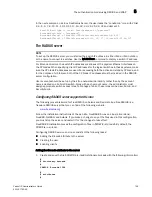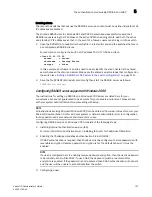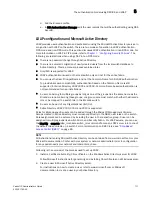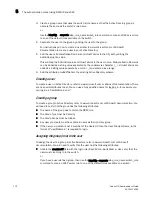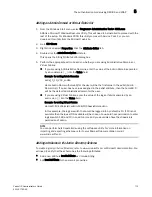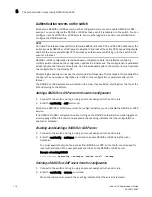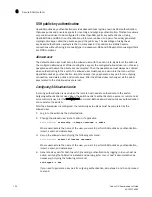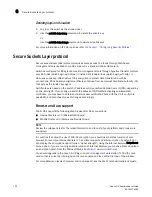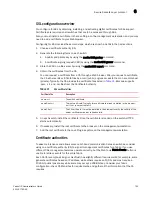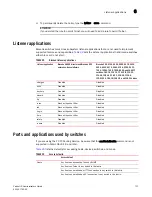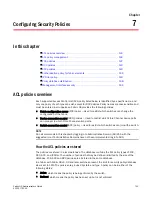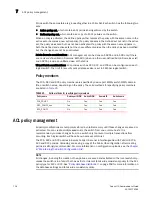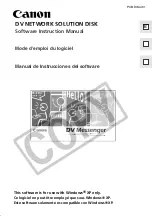
Fabric OS Administrator’s Guide
119
53-1001763-02
Secure Shell protocol
6
Setting up SCP for configUploads and downloads
1. Log in to the switch as admin.
2. Type the configure command.
3. Type y or yes at the
cfgload attributes
prompt.
4. Type y or yes at the
Enforce secure configUpload/Download
prompt.
Example of setting up SCP for configUpload/download
switch:admin>
configure
Not all options will be available on an enabled switch.
To disable the switch, use the "switchDisable" command.
Configure...
System services (yes, y, no, n): [no]
n
ssl attributes (yes, y, no, n): [no]
n
http attributes (yes, y, no, n): [no]
n
snmp attributes (yes, y, no, n): [no]
n
rpcd attributes (yes, y, no, n): [no]
n
cfgload attributes (yes, y, no, n): [no]
y
Enforce secure config Upload/Download (yes, y, no, n): [no] y
Enforce signature validation for firmware (yes, y, no, n): [no]
Secure Shell protocol
To ensure security, Fabric OS supports secure shell (SSH) encrypted sessions. SSH encrypts all
messages, including the client transmission of the password during login. The SSH package
contains a daemon (sshd), which runs on the switch. The daemon supports a wide variety of
encryption algorithms, such as Blowfish-Cipher block chaining (CBC) and Advanced Encryption
Standard (AES).
NOTE
To maintain a secure network, you should avoid using Telnet or any other unprotected application
when you are working on the switch.
The File Transfer Protocol (FTP) is also not secure. When you use FTP to copy files to or from the
switch, the contents are in clear text. This includes the remote FTP server's login and password.
Some example commands of this limitation are: supportSave -k, configUpload, configDownload, and
firmwareDownload.
Commands that require a secure login channel must originate from an SSH session. If you start an
SSH session, and then use the login command to start a nested SSH session, commands that
require a secure channel will be rejected.
Fabric OS v6.1.0 and later support OpenSSH protocol v2.0 (ssh2). For more information on SSH,
refer to the SSH IETF Web site:
http://www.ietf.org/ids.by.wg/secsh.html
For more information, refer to
SSH, The Secure Shell: The Definitive Guide
by Daniel J. Barrett,
Ph. D., Richard E. Silverman, and Robert G. Byrnes.
Summary of Contents for 53-1001763-02
Page 1: ...53 1001763 02 13 September 2010 Fabric OS Administrator s Guide Supporting Fabric OS v6 4 0 ...
Page 4: ...iv Fabric OS Administrator s Guide 53 1001763 02 ...
Page 24: ...xxiv Fabric OS Administrator s Guide 53 1001763 02 ...
Page 28: ...xxviii Fabric OS Administrator s Guide 53 1001763 02 ...
Page 32: ...xxxii Fabric OS Administrator s Guide 53 1001763 02 ...
Page 40: ...xl Fabric OS Administrator s Guide 53 1001763 02 ...
Page 42: ...2 Fabric OS Administrator s Guide 53 1001763 02 ...
Page 54: ...14 Fabric OS Administrator s Guide 53 1001763 02 High availability of daemon processes 1 ...
Page 74: ...34 Fabric OS Administrator s Guide 53 1001763 02 Basic connections 2 ...
Page 102: ...62 Fabric OS Administrator s Guide 53 1001763 02 Audit log configuration 3 ...
Page 214: ...174 Fabric OS Administrator s Guide 53 1001763 02 Management interface security 7 ...
Page 228: ...188 Fabric OS Administrator s Guide 53 1001763 02 Brocade configuration form 8 ...
Page 276: ...236 Fabric OS Administrator s Guide 53 1001763 02 Creating a logical fabric using XISLs 10 ...
Page 404: ...364 Fabric OS Administrator s Guide 53 1001763 02 ...
Page 440: ...400 Fabric OS Administrator s Guide 53 1001763 02 Performance data collection 17 ...
Page 480: ...440 Fabric OS Administrator s Guide 53 1001763 02 F_Port masterless trunking 19 ...
Page 494: ...454 Fabric OS Administrator s Guide 53 1001763 02 Buffer credit recovery 20 ...
Page 574: ...534 Fabric OS Administrator s Guide 53 1001763 02 Hexadecimal overview E ...

